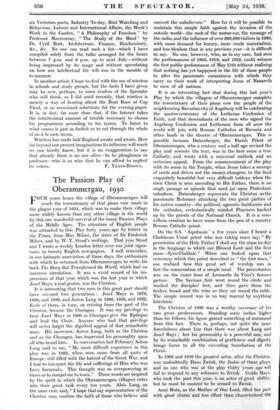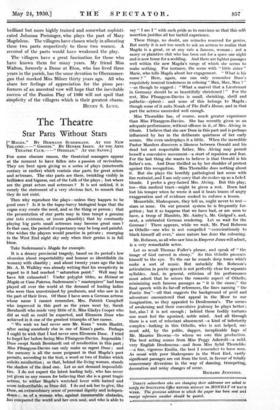The Passion- Play of Oberammergau, 193o F OUR years hence the
village of Oberammergau will -1-. reach the tercentenary of that pious vow made. in the plague year of 1684, which was to make their village more widely known than any other yillage in the world by this one wonderful survival of the many Passion Plays of the Middle Ages. The attention of English people was attracted to this Play forty years ago by letters in the Times, from .Miss Milner, the sister of Sir Fiederiek Milner, and by W. T. Stead's writings. That Year _Stead and I wrote a weekly London letter over our joint signa- tures to twenty English newspapers. I well remember, in our intimate association of those days, the enthusiatin with which he returned from Oberammergau to write his book The Story that Transformed the World, which had an immense circulation. It was a vivid record of his im- pressions of that year which was the list year in which josef Mayr, a real genius, was the Christus. It is interesting that two men in this great part should have covered two generations :: Josef Mayr in 1870, 1880, and 1890, and Anton Lang in .1900, 1910, and 1922. Each of them, in turn, on retiring from the part of the Christus, became the Choragus. It was my privilege to hear Josef Mayr in 1900 as Choragus give the Epilogue and lead the Choir. Anyone who had that privilege will never forget the dignified apPeal of that remarkable man. His successor, Anton Lang, both as the Christut and as the Choragus, has impressed his personality upon all who heard him. In conversation last February Anton Lang said to me, " My most difficult experience in this play was in 1922, when men came from all parts of Europe, still 'filled with the hatred of the Great War; and I had to interpret the life and sufferings of Him who was Love Incarnate. This thought was so overpowering 'at times as to compel me to tears." These words are inspired by the spirit in which the Oberammergau villagers enter into their great task every ten years. Alois Lang, on the same visit, said, " I hope that my representation of the Christus may confirm the faith of those who believe and convert the unbelievers." How far it will be possible to maintain this simple faith against the invasion of the outside world—the rush of the motor-car, the message of the radio, and the influence of over 800,000 visitors in 1930, with more demand for luxury, more crude materialism, and less idealism than in any previous year—it is -difficult to say. No one, however, who, as in my case, had seen the performances of 1900, 1910, and 1922, could witness the first public performance of May 11th without realizing that nothing has yet happened in the life of these people to alter the passionate earnestness with which they carry on their work of interpreting Jesus of Nazareth to men of all nations.
It is an interesting fact that- during this last year's Play by which the villagers' of Oberammergau complete the tercentenary of their pious vow the people of the neighbouring Bavarian city of Augsburg will be celebrating the quatro-centenary of the Lutheran Confession of Faith, and that descendants of the men who signed the Augsburg Confession and Lutherans from all over the world will join' with Roman Catholics of Bavaria and other lands in the theatre of Oberammergau. This is possible • because Daisenberger,- the Parish Priest of Oberammergau, who a century and a half ago revised the play and rewrote the text, was in the best sense a true . Catholic, and wrote with a universal outlook and no sectarian appeal, .Frorn the commencement: of the play with, its scene in the Temple, when Jesus takes a scourge of cords and drives out the money-changers, to the final exquisitely beautiful but very difficult tableau when-the. risen Christ is seen' ascending- to His -Father, there is no single passage or episode that need jar- upon Protestant onlookers. Daisenberger represents the Christus as the passionate Reformer attacking the two great parties' of his native country=the political, agnostic Sadducees and the orthodox, ecclesiastically minded Pharisees backed up by the priests of the National Church. It is a mar- vellous creation to have come from the pen of a country Roman Catholic priest. - • On the S.S. Aquitania ' a few years since I heard si Chaldaean Uniat priest who was taking mass say," By permission of the Holy Father I shall say the mass to-daY in the language in which our Blested Lord said the first mas. s—Syro-Chaldaie." When one looked upon that ceremony which this priest described as " the first mass," one realized how_ this great.. act of worship was in fact the consecration of a simple meal. The presentation was on the exact lines of Leonardo da Vinci's famous picture. The Saviour ;first went round the circle and washed the disciples' feet, and then gave 'them the broken bread and the *hie as they Sat round the table. The' simple 'record was in' no way marred by anything histrionic.
The Christus of 1930 was a worthy successor of his two great predecessors. Standing some inches higher than his fellows; his figure gained-something of command frOth 'this fact. There is, perhaps; not quite the same forcefulness about him that there was _about Lang and Jos_ ofMaYi hii personality is a.powerful one, and by its remarkable combination of gentleness and dignity brings home to all the exceeding humiliation. of the Christ. - - In 1900 and 1910 the-greatest actOi., after the Christus, was undoubtedly Hans Zwink, the Judat of those plays, and 'no one WIIO'wat :at the play thirty years' ago will fail to respond to. any reference to ZwinIF. great Mayr, who took the part this year, is an actor of great ability, but he must be content lo be second to Zwink.
Anni Rutz, as the Mother of Our Lord; filled her part, with -great elidirri 'and lest 7effort-thari vhara*Cterized -thd brilliant but. more highly. trained and somewhat sophisti-. cated Johanna Preisinger, who plays the part of Mary Magdalene. The villagers have chosen wisely in allocating these two parts respectively to these • two women. A reversal of the parts would have weakened the play.
The villagers have a- great fascination for those who have knoWn them for niany . years. My friend Miss Walton, formerly a Dame at Eton, who has lived three years in the parish, has the same devotion to Oberammer- gau that marked Miss Milner thirty years ago.. All who share her feelings of appreciation for the pious per formers of an ancestral vow will hope that the inevitable success of the Passion Play of 1930 will not spoil that simplicity of the villagers which is their greatest charm.
HENRY S. LUNN.







































 Previous page
Previous page